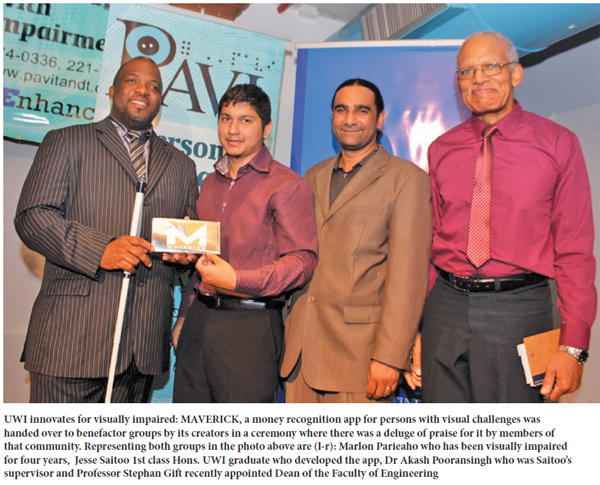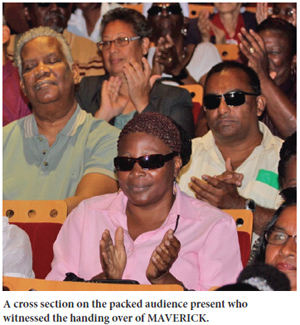 |
 |
 |
|
August 2015
|
He was referencing an app called MAVERICK – which was created by Jessie Saitoo, an under graduate student of the Department of Electrical and Computer Engineering (DECE) of The University of the West (The UWI), St Augustine Campus and presented to some members of the visually impaired community last week. The application MAVERICK is testament to what can happen when a societal problem meets opportunity backed up by institutional strength. The handing over ceremony drew a crowd to the Audio Visual Room at the National Library and Information System Authority (NALIS) in Port of Spain. It all started in 2014 when Marlon Parieaho—a Police Officer, who lost his sight four years ago due to advanced glaucoma—met Jamaican programmer and UWI Electrical and Computer Engineering graduate Ramone Graham. The latter was recruited to work on Mobi Assist—a project which when completed would help persons with visual impairment to safely navigate the streets. Impressed by Graham’s programming skills, team leader Parieaho began questioning the UWI grad about other ways technology can help the visually impaired. “I said you know what would be really cool, if you can develop an app to help blind persons identify different currency denominations,” Parieaho, 35, said. All currency feels basically the same to the visually impaired. Such individual employ techniques like folding their notes, or compartmentalizing denominations in their wallets to distinguish between notes. The problem is that they must rely on others to help them identify the bill before they are folded or compartmentalized. And both methods are meaningless if the person with visual impairment cannot remember how he or she has assigned the notes. Foreign-designed money detectors are not adept at reading TT currency. But techniques, regardless of how fastidiously applied, provide little protection against unscrupulous merchants. Parieaho knows this first hand. He recalled the time he paid for a thirty dollar lunch with a hundred dollar bill and thought that he’d received his correct change. Upon return to work, he discovered from his colleagues that he had in fact received seven single dollars and not the seventy dollars he thought he had. Parieaho got back his money, but he knows too well that such examples of restitution are the exception rather than the norm in his community. Graham arranged for Parieaho to meet and share his concerns with Dr. Akash Pooransingh, his former lecturer in Computer Systems in DECE. “I listened to what Marlon had to say,” Dr. Pooransingh said. “Not only with the money-reader but he expressed other challenges. Marlon was trying to explain what it means to be visually impaired. Marlon himself is an incredible and fascinating individual.” Dr. Pooransingh, whose research area is in image processing, saw an opportunity to engage his students. He proposed the project as a final year undergraduate special project. One student was selected for project from among the best students in the Department. That student was Jesse Saitoo, a National Scholarship winner. Saitoo has become the visually impaired community’s new best friend, judging by the hugs and praises heaped on him during the handing over, which was well represented by the visually impaired community.
Let’s just say that things didn’t go as Jesse imagined. “Basically what Marlon said was he was disappointed, so I was disappointed,” Saitoo said of that meeting. “I went home and started back from scratch. I had to research a new method that would incorporate the feedback.” He did just that, and not only did he eventually produce an app that did the job, he earned himself an A plus. The gravy came when he learned that the journal paper outlining his approach—one based on facial recognition algorithms—was accepted for publication by The West Indian Journal of Engineering. Not bad for a 22-year-old undergrad, who will be graduating this October with First Class Honours. The project is finished; Saitoo’s got his grades, but he is still tweaking the app to perfect it. He said it needed a voice to let the user know that MAVERICK is running. “No, I didn’t feel like Bill Gates,” Saitoo said chuckling at the comparison. “Honestly, I didn’t feel like a UWI student at an undergraduate level could impact the society in this way.” Dr. Pooransingh is excited about the prospect of doing more work with the visually impaired community. In fact, he said that the newly appointed Dean of Department, Professor Stephan Gift has shared his plans for an Innovation Centre which will see even more innovative ideas emerge from the Faculty of Engineering. The MAVERICK app is currently available for download on PAVI’s website: www.pavitandt.org Natasha Coker Jones is a free-lance writer and editor. |


 “I saw it as a blind person’s independence day,” Marlon Parieaho, a member of a local NGO called Persons Associated with Visual Impairment (PAVI), said of the hand-over day of an app that allows persons in Trinidad and Tobago living with visual impairment to identify their local currency bills without assistance from the sighted .
“I saw it as a blind person’s independence day,” Marlon Parieaho, a member of a local NGO called Persons Associated with Visual Impairment (PAVI), said of the hand-over day of an app that allows persons in Trinidad and Tobago living with visual impairment to identify their local currency bills without assistance from the sighted . Saitoo hunkered down to work immediately after receiving the nod. As part of the requirements for this project, he had to take Visual Media Processing, a Masters course. This equipped him with the image processing theory required to execute the project. Dr. Pooransingh reported that every two weeks, Saitoo would come with a new and improved version of the app. The moment of truth came in February 2015, when Saitoo met Parieaho for the first time.
Saitoo hunkered down to work immediately after receiving the nod. As part of the requirements for this project, he had to take Visual Media Processing, a Masters course. This equipped him with the image processing theory required to execute the project. Dr. Pooransingh reported that every two weeks, Saitoo would come with a new and improved version of the app. The moment of truth came in February 2015, when Saitoo met Parieaho for the first time.